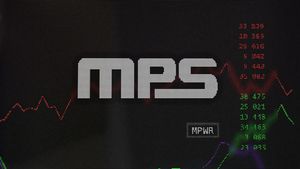- BUFQ provides access to a laddered portfolio of four FT Cboe Vest Nasdaq-100® Buffer ETFs, diversifying risk across time and market conditions
- BUFQ joins First Trust’s growing ETF "fund of funds" lineup which invest in Target Outcome Funds®
First Trust Advisors L.P. (“First Trust”) a leading exchange-traded fund (“ETF”) provider and asset manager, announced today that it has launched the FT Cboe Vest Fund of Nasdaq-100® Buffer ETFs (Cboe: BUFQ) (the “fund”). BUFQ is designed to provide equity investors with an ongoing risk management strategy by investing substantially all of its assets in a portfolio of four FT Cboe Vest Nasdaq-100® Buffer ETFs (“Underlying ETFs” or “Target Outcome Buffer ETFs”).
BUFQ uses a laddered approach to invest in the Underlying ETFs, which utilize an options strategy that seeks to provide a downside buffer against the first 10% of losses (before fees, expenses and taxes) with upside potential, up to a predetermined cap, based on the price return of the Invesco QQQ TrustSM, Series 1 (QQQ) for a Target Outcome Period of approximately one year. Unlike the Underlying ETFs, the fund itself does not pursue a defined outcome strategy. The buffer is only provided by the Underlying ETFs and the fund itself does not provide any stated buffer against losses. The fund will likely not receive the full benefit of the Underlying ETF buffers and could have limited upside potential. The fund's returns may be limited to the caps of the Underlying ETFs.
“Today’s launch of BUFQ satisfies a demand from investors seeking a risk-diversified way to participate in some of the upside of tech-heavy QQQ stock holdings, with a level of protection against losses. BUFQ offers exposure to Target Outcome ETFs® on QQQ, with a convenient built-in laddered approach that recalibrates a portion of the investment to the prevailing levels of QQQ each quarter,” said Karan Sood, CEO of Cboe Vest. “There has been a steady increase in demand for risk-diversified buffer investments since 2016, when we introduced a laddered portfolio of buffer strategies in a registered investment company. We are pleased to have yet another risk-diversified buffer ETF available for investors,” Sood added.
The four Underlying ETFs held by the fund each have a Target Outcome Period that resets annually at different quarterly intervals, creating a diversified or “laddered” Target Outcome strategy. Designed for investors looking to use the Underlying ETFs to mitigate risk in the context of asset allocation, a laddered approach can reduce timing risks over the long term, by providing diversification of the investment time period and market level. Depending on when the fund purchases shares of an Underlying ETF, the cap and/or buffer of an Underlying ETF may be exhausted despite utilizing a laddered approach, unless the fund buys shares at the beginning of a Target Outcome Period. The relevant Underlying ETF’s cap is reset at prevailing market conditions at the onset of each new Target Outcome Period. The cap for each Underlying ETF’s subsequent outcome period will likely differ from its initial outcome period. Because the fund typically will not purchase shares of the Underlying ETFs on the first day of a Target Outcome Period, it is not likely that the stated outcomes for a Target Outcome Period will be realized or fully realized by the fund.
“Risk management is at the forefront of investors’ minds this year as volatility has surged. We believe this ETF may be an effective tool for investment professionals seeking to maintain an allocation to some of the most innovative companies in the world, while providing some level of downside protection on the underlying ETF holdings,” said Ryan Issakainen, CFA, Senior Vice President, ETF Strategist at First Trust.
Karan Sood and Howard Rubin, of Cboe Vest, will serve as portfolio managers for the fund. The portfolio managers are jointly and primarily responsible for the day-to-day management of the fund.
For more information about First Trust, please contact Ryan Issakainen at (630) 765-8689 or RIssakainen@FTAdvisors.com.
About First Trust
First Trust is a federally registered investment advisor and serves as the fund’s investment advisor. First Trust and its affiliate First Trust Portfolios L.P. (“FTP”), a FINRA registered broker-dealer, are privately held companies that provide a variety of investment services. First Trust has collective assets under management or supervision of approximately $203 billion as of May 31st, 2022 through unit investment trusts, exchange-traded funds, closed-end funds, mutual funds and separate managed accounts. First Trust is the supervisor of the First Trust unit investment trusts, while FTP is the sponsor. FTP is also a distributor of mutual fund shares and exchange-traded fund creation units. First Trust and FTP are based in Wheaton, Illinois. For more information, visit www.ftportfolios.com.
About Cboe Vest:
Cboe Vest is the creator of Target Outcome Investments®, which strive to buffer losses, manage volatility, amplify gains, or provide consistent income to a diverse spectrum of investors. Today, Cboe Vest’s Target Outcome Strategies® are available in mutual funds, exchange-traded funds (ETFs), unit investment trusts (UITs), collective investment trusts (CITs), and customizable managed accounts / sub-advisory services. For more information about Cboe Vest and the evolution of Target Outcome Investments, visit cboevest.com or contact Linda Werner at lwerner@cboevest.com or 703-864-5483.
You should consider the fund’s investment objectives, risks, and charges and expenses carefully before investing. Contact First Trust Portfolios L.P. at 1-800-621-1675 or visit www.ftportfolios.com to obtain a prospectus or summary prospectus which contains this and other information about the fund. The prospectus or summary prospectus should be read carefully before investing.
Risk Considerations
You could lose money by investing in a fund. An investment in a fund is not a deposit of a bank and is not insured or guaranteed. There can be no assurance that a fund's objective(s) will be achieved. Investors buying or selling shares on the secondary market may incur customary brokerage commissions. Please refer to each fund's prospectus and SAI for additional details on a fund's risks. The order of the below risk factors does not indicate the significance of any particular risk factor.
There can be no assurance that an active trading market for fund shares will develop or be maintained.
A fund that invests in underlying ETFs that use FLEX Options to employ a "target outcome strategy" ("Underlying ETFs"), does not itself pursue a defined outcome strategy. The buffer is only provided by the Underlying ETFs and the fund itself does not provide any stated buffer against losses. There can be no guarantee that the Underlying ETFs will be successful in their strategy to buffer against losses. A fund may lose its entire investment in an Underlying ETF. To the extent a fund acquires shares of its Underlying ETFs in connection with creations and during reallocation, the fund typically will not acquire Underlying ETF shares on the first day of the target outcome period defined in the Underlying Fund's prospectus ("Target Outcome Period"). Likewise, to the extend a fund disposes of shares of an Underlying ETF in connection with redemptions and during reallocation, any such disposition typically will not incur on the last day of a Target Outcome Period.
A new Underlying ETF cap is established at the beginning of each Target Outcome Period and is dependent on prevailing market conditions. As a result, a cap may rise or fall from one Target Outcome Period to the next and is unlikely to remain the same for consecutive Target Outcome Periods.
If the Underlying ETF's reference security or index experiences gains during a Target Outcome Period, an Underlying ETF will not participate in those gains beyond the cap. In the event a fund purchases shares of an Underlying ETF after the first day of a Target Outcome Period and the Underlying ETF has risen in value to a level near the cap, there may be little or no ability for the fund to experience an investment gain on its shares; however, the fund will remain vulnerable to downside risk.
A fund may be subject to the risk that a counterparty will not fulfill its obligations which may result in significant financial loss to a fund.
A fund is susceptible to operational risks through breaches in cyber security. Such events could cause a fund to incur regulatory penalties, reputational damage, additional compliance costs associated with corrective measures and/or financial loss.
A fund may invest in the shares of other ETFs, which involves additional expenses that would not be present in a direct investment in the underlying funds. In addition, a fund’s investment performance and risks may be related to the investment performance and risks of the underlying funds.
The Underlying ETFs invest in FLEX Options. Trading FLEX Options involves risks different from, or possibly greater than, the risks associated with investing directly in securities. An Underlying Fund may experience substantial downside from specific FLEX Option positions and certain FLEX Option positions may expire worthless. There can be no guarantee that a liquid secondary trading market will exist for the FLEX Options and FLEX options may be less liquid than exchange-traded options.
FLEX Options are subject to correlation risk and a FLEX Option's value may be highly volatile, and may fluctuate substantially during a short period of time. FLEX Options will be exercisable at the strike price only on their expiration date. Prior to the expiration date, the value of the FLEX Options will be determined based upon market quotations or other recognized pricing methods. In the absence of readily available market quotations for fund holdings, a fund’s advisor may determine the fair value of the holding, which requires the advisor’s judgement and is subject to the risk of mispricing or improper valuation.
Stocks with growth characteristics tend to be more volatile than certain other stocks and their prices may fluctuate more dramatically than the overall stock market.
Information technology companies are subject to certain risks, including rapidly changing technologies, short product life cycles, fierce competition, aggressive pricing and reduced profit margins, loss of patent, copyright and trademark protections, cyclical market patterns, evolving industry standards and regulation and frequent new product introductions.
Large capitalization companies may grow at a slower rate than the overall market.
The portfolio managers of an actively managed portfolio will apply investment techniques and risk analyses that may not have the desired result.
Market risk is the risk that a particular security, or shares of a fund in general may fall in value. Securities are subject to market fluctuations caused by such factors as general economic conditions, political events, regulatory or market developments, changes in interest rates and perceived trends in securities prices. Shares of a fund could decline in value or underperform other investments as a result. In addition, local, regional or global events such as war, acts of terrorism, spread of infectious disease or other public health issues, recessions, or other events could have significant negative impact on a fund. In February 2022, Russia invaded Ukraine which has caused and could continue to cause significant market disruptions and volatility within the markets in Russia, Europe, and the United States. The hostilities and sanctions resulting from those hostilities could have a significant impact on certain fund investments as well as fund performance. The COVID-19 global pandemic has caused and may continue to cause significant volatility and declines in global financial markets. While the U.S. has resumed "reasonably" normal business activity, many countries continue to impose lockdown measures. Additionally, there is no guarantee that vaccines will be effective against emerging variants of the disease.
Large inflows and outflows may impact a new fund’s market exposure for limited periods of time.
A fund classified as “non-diversified” may invest a relatively high percentage of its assets in a limited number of issuers. As a result, a fund may be more susceptible to a single adverse economic or regulatory occurrence affecting one or more of these issuers, experience increased volatility and be highly concentrated in certain issuers.
A fund and a fund's advisor may seek to reduce various operational risks through controls and procedures, but it is not possible to completely protect against such risks. The fund also relies on third parties for a range of services, including custody, and any delay or failure related to those services may affect the fund’s ability to meet its objective.
The prices of options are volatile and the effective use of options depends on a fund's ability to terminate option positions at times deemed desirable to do so. There is no assurance that a fund will be able to effect closing transactions at any particular time or at an acceptable price.
High portfolio turnover may result in higher levels of transaction costs and may generate greater tax liabilities for shareholders.
The market price of a fund's shares will generally fluctuate in accordance with changes in the fund's net asset value ("NAV") as well as the relative supply of and demand for shares on the exchange, and a fund's investment advisor cannot predict whether shares will trade below, at or above their NAV.
If a fund's Underlying ETF holds FLEX Options that reference QQQ, the fund is subject to certain of the risks of owning shares of an ETF as well as the risks of the types of instruments in which QQQ invests.
If a fund's Underlying ETF holds FLEX Options that reference QQQ, each Underlying ETF has exposure to the equity securities markets. Equity securities may decline significantly in price over short or extended periods of time, and such declines may occur in the equity market as a whole, or they may occur in only a particular country, company, industry or sector of the market.
A fund may have temporary larger exposures to certain Underlying ETFs and under such circumstances, a fund’s return would be more greatly influenced by the returns of the Underlying ETFs with the larger exposures.
An Underlying ETF's investment strategy is designed to deliver returns if shares are bought on the first day that the Underlying ETF enters into the FLEX Options and are held until the FLEX options expire at the end of the Target Outcome Period subject to the cap.
If a fund does not qualify as a RIC for any taxable year and certain relief provisions were not available, a fund's taxable income would be subject to tax at the fund level and to a further tax at the shareholder level when such income is distributed. Further, there may be other tax implications to a fund based on the type of investments in a fund.
Trading on an exchange may be halted due to market conditions or other reasons. There can be no assurance that a fund's requirements to maintain the exchange listing will continue to be met or be unchanged.
A fund that invests in Underlying ETFs may provide returns that are lower than the returns that an investor could achieve by investing in one or more Underlying ETFs alone and the fund bears its proportionate share of each ETF's expenses, subjecting fund shareholders to duplicative expenses. A fund of Underlying ETFs does not itself pursue a defined outcome strategy and does not provide any buffer against Underlying ETF losses.
The information presented is not intended to constitute an investment recommendation for, or advice to, any specific person. By providing this information, First Trust is not undertaking to give advice in any fiduciary capacity within the meaning of ERISA, the Internal Revenue Code or any other regulatory framework. Financial professionals are responsible for evaluating investment risks independently and for exercising independent judgment in determining whether investments are appropriate for their clients.
Cboe® is a registered trademark of Cboe Exchange, Inc., which has been licensed for use in the name of the fund. The funds is not sponsored, endorsed, sold or marketed by Cboe Exchange, Inc. or any of its affiliates (“Cboe”) or their respective third-party providers, and Cboe and its third-party providers make no representation regarding the advisability of investing in the fund and shall have no liability whatsoever in connection with the fund.
The fund and the underlying ETFs are not sponsored, endorsed, sold or promoted by Invesco QQQ Trust℠, Series 1, Invesco, or Nasdaq, Inc., (together with their affiliates hereinafter referred to as the “Corporations”). The Corporations have not passed on the legality or suitability of, or the accuracy or adequacy of, descriptions and disclosures relating to the funds or the underlying ETFs. The Corporations make no representations or warranties, express or implied, regarding the advisability of investing in the funds or the underlying ETFs or results to be obtained by the funds or the underlying ETFs, shareholders or any other person or entity from use of the Invesco QQQ Trust℠. The Corporations have no liability in connection with the management, administration, marketing or trading of the funds or the underlying ETFs.
Cboe VestSM is a service mark of Cboe Exchange, Inc.
Target Outcome®, Target Outcome Investments®, Target Outcome Strategies® and Target Outcome ETFs® are registered trademarks of Cboe Vest Financial LLC.
Definitions:
QQQ - The Invesco QQQ TrustSM, Series 1 is an exchange-traded fund based on the Nasdaq-100® Index.
Nasdaq-100® Index - The Index is a basket of the 100 largest, most actively traded U.S companies listed on the Nasdaq stock exchange. The Index includes companies from various industries except for the financial industry, like commercial and investment banks.
View source version on businesswire.com: https://www.businesswire.com/news/home/20220616005603/en/
Contacts
Ryan Issakainen
First Trust
(630) 765-8689
RIssakainen@FTAdvisors.com







